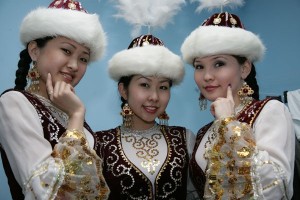Now that the Kalbeliya costume is finally finished I have collected so many ideas in my head that I am working now not on one "historical" costume, but on two simultaneously.
(N.B.: Rereading this article I have the impression to have written an anti-tribal-fusion statement. I do not at all disrespect any kind of fusion work, on the contrary, it has it's own charm and is an artform in itself! But it has a totally different background than what I am trying to do in this moment.)
When I say "historical" costume this means that I do an accurate research on a specific region and a certain time period. Then I usually choose a whole outfit that I try to reproduce including accessoires like headpieces, shoes and jewellery. On this base I choose the matching music to form a dance out of that.
But when it comes to reconstruction there are a lot of different levels of historical accuracy to follow. How much must my work adhere to them?
Thinking of my next projects these are the questions I posed to myslf and also how to answer them for myself - regarding only my own work right now. I do not want to make any absolute judgements, I just want to clear my ideas in order to achieve a round and coherent outcome!
 |
| Modern version of a traditional Algerian costume - from a magazine of the famous Algerian Designer Samira Bezaouia Sadek |
Can I mix pieces of different outfits?
The answer is difficult. As documentary material may be scarce I will be forced to invent something in any case. BUT - and this is crucial for me - I want to have a coherent work, this means, that if I borrow pieces (and, when it comes to dances, movements) from another, similar source, I want to make sure that the pieces will not
loose their initial meaning by being put into an alien surrounding. This may sound really cryptic. I mean, that the pieces should match and should not be used out of their context regarding religion, social strata and regional peculiarity. So I would not combine, e.g. a peasant woman's apron with an urban headpiece.
Mixing signs of different religious or ethnic communities is not only a sign of a certain ignorance; it might even be regarded as an insult to a member of those. So be very careful with eclectic compositions and have always your audience in mind.
The gender aspect is also very important in non westernized societies. Although I see a certain shift in contemporary ethnic stage dance and costuming (e. g. in some of the new pieces of the sukhilshvilebi from Georgia) I'd rather leave those challenges of their own society to them. As an outsider I can never be sure what denotation it will create on the indigenous audience.
Whenever we approach and try to appropriate a different culture we should be very careful not to destroy the whole systems of meanings that holds it, otherwise we risk to act not only out of ignorance but in a colonialistic way.
This is what I mean by "authentic".
I know this sound sooo conservative! But where is my free artistic expression?! you may ask.
I find a lot of it even in this cautious approach. Some of the freedom comes simply out of material renouncement. I adore, for example, handloomed textiles, and love the very few scarfs that I own. But historical garments need a lot more fabric than our modern ones. And I would have to order them from India, and that is pricey. So, in this case I am very relaxed. I use modern, even synthetic, fabrics when I think they match the styling. I use my sewing machine, I use zippers, fabric glue, faux pearls, acrylic beads, glitter, and so on.
And I also adopt and combine modern crafting techniques which are completely non related to the historical background of a costume. So on a balkan style coat I will put not only the traditional gold work, but also holographic sequins and Japanese inspired Kanzashi flowers.
 |
| Random material for goldwork on an velvet coat |
Last not least the music I like to use gives me the directions, how to incorporate modern techniques into an authentic dance costume and piece.
These are so far the limitations I put on myself for my work right now. And after that - I will probably make a completely crazy fusion thing! :-)
What is your opinion about all that? Please share!




































